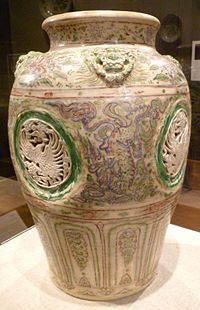Le Dynasty jar
The Lê Dynasty jar is a large, ornate, well-preserved 15th or 16th century carved stoneware jar produced in Lê Dynasty Vietnam. It was acquired from a Thai collector in 2011 and is now a part of the Asian collection at the Birmingham Museum of Art.
The thin-walled, 24¼-inch-tall stoneware jar was made from gray-white clays dug from the Red River Valley. It was carved and incised and its surface painted and glazed with elaborate and intricate multi-layered decorations. The decorative scheme, replete with symbols of luck and prosperity, reflects cultural influences of Ming Dynasty China, which suppressed local cultural traditions during its occupation of Vietnam from 1407 to 1427.
A photograph of the jar was published in the 1997 book Vietnamese Ceramics: A Separate Tradition. Co-author John Stevenson assisted BMA curator Don Wood in locating the piece in the possession of a private collector in Bangkok. Finding the jar to be in exquisite condition, the museum applied funds from a bequest from the William Spencer III estate to purchase it. London's Apollo magazine declared the purchase to represent the world's 9th most important public art acquisition of the year.
The jar's first public display was as the centerpiece of the "Dragons and Lotus Blossoms" exhibition which opened on January 22, 2012.
Reference
- Negrotti, Rosanna (December 1, 2011) "Acquisition of the Year" Apollo
- Huebner, Michael (December 8, 2011) "Vietnamese jar acquired by Birmingham Museum of Art cited by London art magazine." The Birmingham News
- Wood, Don (December 2013) "Jar, Vietnam, 16th century". Spotlight on the Collection. Birmingham Museum of Art
External link
- Birmingham Museum of Art Home Page.
